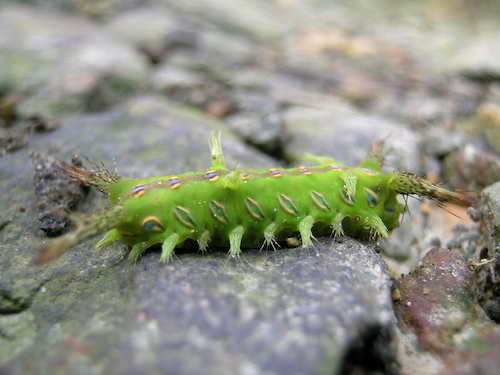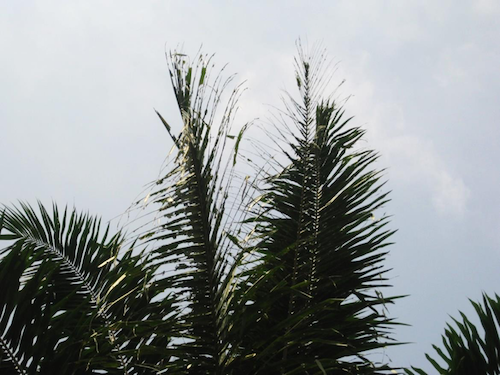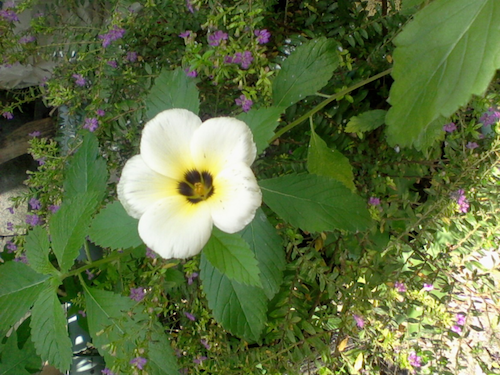Budidaya Kelapa Sawit Berkelanjutan / Serangga pemakan-daun
Download: Module 5: Pests and Diseases
Contents
Background

There are several leaf-eating pests which sometimes infest oil palm plantations. The most important ones in Southeast Asia are bagworms (Pteroma pendula, Metisa plana, Mahasena corbetti), tussock moths (Dasychira spp., Orgyia spp.), and nettle caterpillars (Darna trima, Setora nitens, Setothosea asigna; see Figure 8).
Each of these insects eats through the oil palm leaf, so their presence is easily recognisable by the holes in the leaves (see Figure 9). In severely infested palms, only the midribs of the leaflets are left, so the palm cannot capture much sunlight and the yield will be strongly reduced. Prevention and management of outbreaks is therefore important.
Natural enemies are insects which kill pests, for example by laying their eggs in the pest larvae. The natural enemies of leaf-eating pests live in the weeds in and around the plantation (see Module 3: Plantation Maintenance for suggestions on how to manage weeds). If all weeds are killed, the natural enemies will die or move away, and outbreaks of leaf-eating pests will become more likely. But even in well-maintained plantations, outbreaks can still occur.
Managing pests requires careful monitoring and the correct use of hazardous chemicals. Both the monitoring and the application of chemicals should be carried out by trained workers. If farmer groups want to establish monitoring and spraying teams, it is necessary to ask for help from extension workers or nearby plantation companies. In this handbook, we discuss only preventive measures, because monitoring and spraying need to be taught in the field by specialised professionals.
Goal
Keep leaf-eating insect damage to oil palms to a minimum.
Standard
Maintenance of the plantation is up to standard and promotes the biological control of leaf-eating insect populations.
Equipment and materials
Seeds and beneficial plants.
Table 1: Beneficial plants
| Scientific name | English name |
|---|---|
| Turnera subulata (white flower) | White buttercup |
| Turnera ulmifolia (yellow flower) | Yellow alder |
| Cassia tora, Cassia cobanensis | Senna |
| Spermacoce alata | Winged false buttonweed |
| Elephantopus tomentosus | Common elephant’s foot |
| Antigonon leptopus | Mexican creeper |
| Euphorbia heterophylla | Lechosa |
Timing
- Planting beneficial weeds: at the start of plantation rehabilitation;
- Doing correct weed maintenance: continuously.
Labour time requirement
Depending on the number of beneficial weeds planted.
Who
Farmers and their family or hired labourers.
How
- Maintain a dense ground cover canopy (see Module 3: Plantation Maintenance);
- Plant weeds that are specifically attractive for natural enemies of pests (e.g. Cassia cobanensis, Euphorbia heterophylla, Antigonon leptopus, Turnera subulata) (see Figure 10).
Note: These weeds are usually not shade tolerant and should therefore be planted at roadsides or in open spots where palms have died.
Data recording
Every pest prevention activity should be recorded in a logbook as shown in the example below.
| Date | Time | Location | Activity | Input type | Input amount | Input costs | Labour input | Labour costs | |
| People | Hours | ||||||||
| 16/01/13 | Field 3 | Planting Euphorbia heterophylla | Euphorbia heterophylla seed | 3 | 8 | 240000 | |||
References
- ↑ L.P. Koh, 2006, Oil palm: pest, Nettle caterpillar, Flickr, https://www.flickr.com/photos/drlianpinkoh/5391807353, Accessed 20 July 2015.
Acknowledgements
The material from Leaf-eating insects is sourced from Smallholder Oil Palm Handbook and put together by Lotte Suzanne Woittiez (Wageningen Universit) and Haryono Sadikin, Sri Turhina, Hidayat Dani, Tri Purba Dukan, and Hans Smit (SNV) in August 2016. See Module 5: Pests and Diseases for more information.





